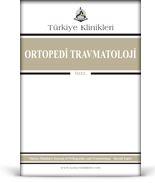Amaç: Bu çalışmada kliniğimize femur boyun kırığı nedeniyle başvuran ve parsiyel kalça protezi uygulanan hastaların klinik sonuçlarını ve litaratür verileriyle karşılaştırarak sunmayı amaçladık. Gereç ve Yöntemler: Bu çalışmaya Haziran 2010 ile Ocak 2015 yılları arasında Yüzüncü Yıl Üniversitesi Tıp Fakültesi Ortopedi ve Travmatoloji kliniğine femur boyun kırığı nedeniyle başvuran ve çimentolu parsiyel kalça protezi ile tedavi edilip önerilen şekilde kontrole gelip kontrolleri kayıt altında tutulan 61 hasta dahil edildi. Ortalama yaş 81,8, kırık ekstremite 41 hastada solda ve 20 hastada sağda idi. Hastalarda kırık sınıflaması Garden sınıflamasına göre, osteoporoz değerlendirmesi Sign indeksine, yerleştirilen protezin uygunluğu Kwok kriterlerine, heterotopik ossifikasyon Broker sınıflamasına, kalça eklemi değerlendirmesi Harris kalça skorlamasına göre yapıldı. Bulgular: Hasta hikayelerine göre tüm hastaların kırıklarının %95'sı araç içi trafik kazası sonrası gelişmişti. Olguların %90,2'sinde patolojik düzeyde osteoporoz mevcuttu. Takiplerde 4 hastada çıkık gelişti. Hastaların %8,2'sinde erken dönemde yüzeyel yara infeksiyonu gelişti. Ortalama takip süresi 22,1 ay olan hastalarımızın mortalite oranı %24,6 ve bunun %16,4'ü ilk 1 yıl içinde gerçekleşti. Hastalarımızın %55,7'sine genel anestezi verilirken % 44,3'üne spinal veya epidural anestezi uygulandı. Kırıklar Garden sınıflamasına göre %1,6 Garden tip 1, %21,3 Garden tip 2, %40,1 Garden tip 3 ve %36,1 Garden tip 4 olarak belirlendi. Protezin erken dönem değerlendirmesinde %49,2 hasta Kwok tip 4, %40,1 hasta Kwok tip 3, %3,3 hasta Kwok tip 2 olarak değerlendirildi. Heterotopik ossifikasyon olarak %8,2 hastada Broker evre 1 heterotopik ossifikasyon tesbit edildi. Bunların hiçbirine bunun için müdahale yapılmadı. Takip süresi sonunda olguların %26,2 si herhangi bir destek almadan yürüyebiliyordu. Hastalarda Harris kalça skoru ortalama 70,5 (36-95) olarak bulundu. Son kontrolde hastaların hiçbirinde ameliyata bağlı siyatik sinir defisiti saptanmadı. Sonuç: Kalça kırığı sonrası hastanın aktivite düzeyini belirleyen en önemli parametre kişinin kırık öncesi aktivite düzeyi olduğu görülmüştür. Ameliyat öncesi desteğe ihtiyacı olan hastaların ameliyat sonrası rehabilitasyona uyumda ciddi zorluklar yaşadığı ve yatağa bağımlı hale geldikleri saptanmıştır. Ayrıca ameliyat sonrası mortalite oranı hastanın eşlik eden komorbid hastalık sıklığı ile ilişkili olduğuna inanmaktayız.
Anahtar Kelimeler: Artroplasti, replasman, kalça; kalça protezleri; femoral boyun kırıkları; cerrahi
Objective: İn this study we aimed to present, by comparing clinical data with literature, the results of patients who were admitted our clinic due to femoral neck fractures and has treated by cemented partial hip arthroplasty. Materials and Methods: This study has included 61 patients who underwent cemented partial hip prosthesis, followed up as recommended and have recording documentation, due to femoral neck fractures betwen June 2010- January 2015 in the Orthopaedic and Travmatology Clinic of Yüzüncü Yıl Üniversity Medical Faculty. The mean age was 81.8(distrubution: ), fractured ekstremity were left in 41 patients and 20 patients were right. The fractures classificated according to Garden Classification, the hip joint functions evaluated according to Harris Hip Scale, the osteoporozis evaluated according to Sign index, the eligibility of prosthesis evaluated according to Kowk Criteria and the heterotopic ossification evaluated according to the Broker's Classification. Average follow-up was 22.1(distrubution:) months. The mortality rate of patients was 24.6% and 16.4% of this mortality was occured in the first year. Results: Accorging to patients history 95.1% of patiens fractures were caused by a simple fall, 3.3% of patients underwent non-vehicle traffic accident and 1,6% of patients fractures was occured after car accident. 90.2% of the patients had pathological level osteoporosis. During fallowing up hip joint dislocation occurred in 4 patients. İn the 8.2% of patients superficial wound infection were occured in the early period. 55.7% of the patients have been applied general anesthesia and 44.3% of the patients underwent spinal or epidural anesthesia. The fractures classificated according to the Garden classification and 40.1% was Type III, 36.1 % Type IV, 21.3% Type II, 1.6 % Type I. The eligibility of early time of prosthesis status evaluated according to Kowk criteria. 49.2% of patients was evaluated as Kowk 4, 40.1% Kowk 3, 3.3% Kowk 2. Heterotopic ossification was evaluated according to the Broker's classification and only 8.2% of patients were identified Boker grade I heterotopic ossification. None of these patients have treated for heterotopic ossification. 26.2% of patients could walked without any support at the end of follow-up period. The patients Harris Hip Score average was found 70.5 (36-95). In the last control was not determined sciatic nerve deficits depended surgery with any paient. Conclusion: The most important parameter has been seen that a person's level of activity after fractures depend on activity level before fracture. It has been determined when patients need to support to walk before frcture happened they encounter with serious difficulties to adapt rehabilitation program and they become bedridden after surgery. İn addition we believe that post-operative mortality rate is releated to comorbid diseases frequency.
Keywords: Arthroplasty, replacement, hip; hip prosthesis; femoral neck fractures; surgery







.: Process List